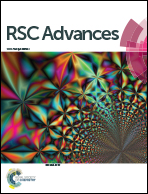Photosensitive polyoxometalate-induced formation of thermotropic liquid crystal nanomaterial and its photovoltaic effect†
Abstract
The photosensitive polyoxometalate (POM) [PW11O39RhCH2CO2H]5− was first introduced into the liquid crystal material through the encapsulation of dimethyldioctadecylammonium (DODA+). The theoretical calculation was performed to simulate the distribution of DODA+ around the POM anion. The surface photovoltage spectroscopy (SPS) result indicated that the hybrid exhibits the photovoltaic effect upon optical illumination and displays the character of a p-type material, which paves a new way for their potential application in the optoelectronics.


 Please wait while we load your content...
Please wait while we load your content...